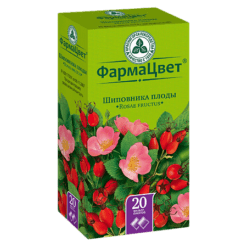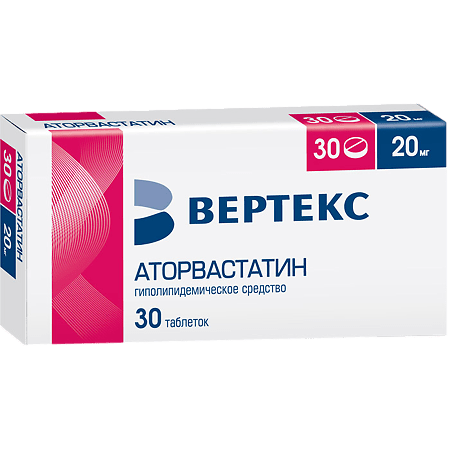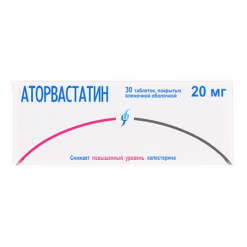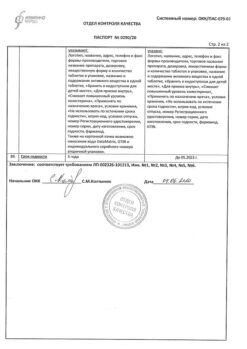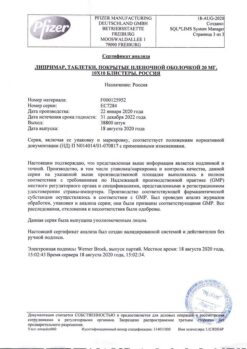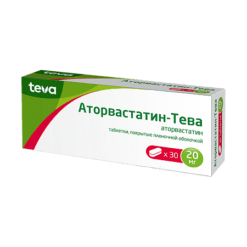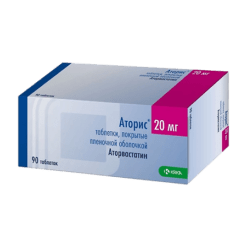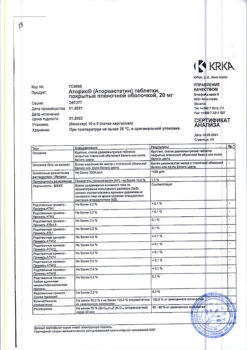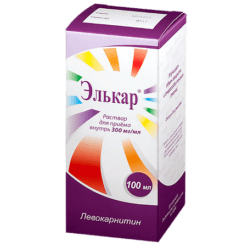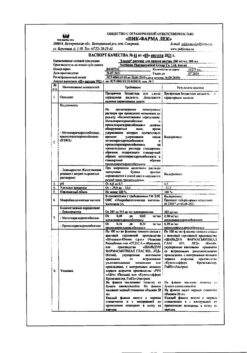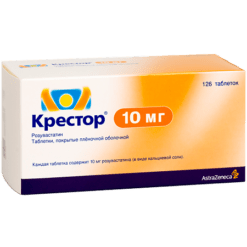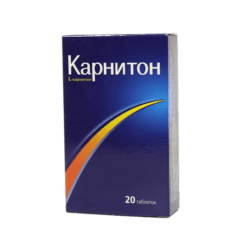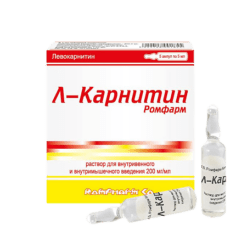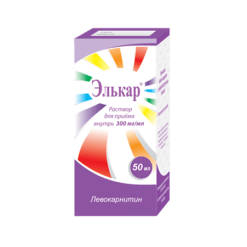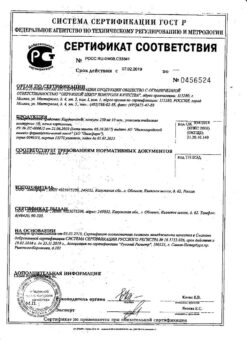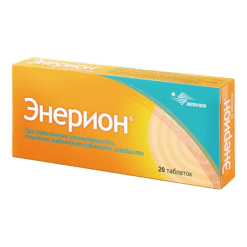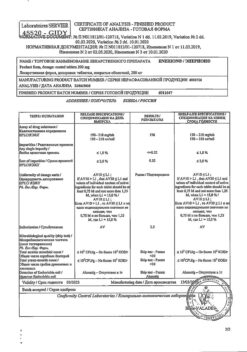Subtotal: €5.76
Atorvastatin-Vertex, 20 mg 30 pcs
€11.90 €10.41
Out of stock
(E-mail when Stock is available)
Pharmacodynamics
Atorvastatin is a hypolipidemic drug from the group of statins. Selective competitive inhibitor of HMG-CoA reductase – an enzyme that converts 3-hydroxy-3-methylglutaryl coenzyme A into mevalonic acid, which is a precursor of sterols, including cholesterol. Triglycerides (TG) and cholesterol in the liver are incorporated into very low-density lipoproteins (VLDL), entered into the blood plasma and transported to peripheral tissues. Low-density lipoproteins (LDL) are formed from VLDL during interaction with LDL receptors. Atorvastatin reduces plasma levels of cholesterol and lipoproteins by inhibiting HMG-CoA reductase, cholesterol synthesis in the liver and increasing the number of “hepatic” LDL receptors on cell surface that leads to increased capture and catabolism of LDL.
Decreases formation of LDL, causes a marked and persistent increase in LDL receptor activity. Reduces LDL levels in patients with homozygous familial hypercholesterolemia, which usually does not respond to therapy with hypolipidemic agents. Reduces total cholesterol by 30-46%, LDL by 41-61%, apolipoprotein B by 34-50% and TG by 14-33%; causes an increase in HDL (high-density lipoprotein) cholesterol and apolipoprotein A. Dose-dependently reduces LDL levels in patients with homozygous hereditary hypercholesterolemia resistant to therapy with other hypolipidemic agents.
Pharmacokinetics
Absorption is high. Maximal concentration (Cmax) in plasma is reached after 1-2 hours, Cmax in women is 20% higher, area under the curve/concentration, time (AUC) is 10% lower; Cmax in patients with alcoholic liver cirrhosis is 16 times higher, AUC is 11 times higher than normal.
Food slightly reduces speed and duration of drug absorption (by 25% and 9%, respectively), but decrease of LDL cholesterol is similar to that with Atorvastatin without food. Concentration of Atorvastatin when administered in the evening is lower than in the morning (approximately by 30%). A linear relationship between the degree of absorption and the drug dose has been found.
Bioavailability is 12%, systemic bioavailability of HMG-CoA reductase inhibitory activity is 30%. Low systemic bioavailability is due to presystemic metabolism in the gastrointestinal mucosa and during “first passage” through the liver.
The average volume of distribution is 381 liters, the binding to plasma proteins is 98%. It is metabolized mainly in liver under the action of CYP3A4, CYP3A5 and CYP3A7 cytochrome with formation of pharmacological active metabolites (ortho- and parahydroxylated derivatives, beta-oxidation products). In vitro, ortho- and parahydroxylated metabolites have an inhibitory effect on HMG-CoA reductase, comparable with that of Atorvastatin. The inhibitory effect of the drug against HMG-CoA reductase is approximately 70% determined by the activity of circulating metabolites.
Extracted with bile after hepatic and/or extrahepatic metabolism (not subjected to marked intestinal-hepatic recirculation).
The elimination half-life is 14 hours. Inhibitory activity against HMG-CoA reductase lasts about 20-30 hours due to the presence of active metabolites. Less than 2% of the oral dose is detected in the urine. It is not excreted during hemodialysis.
Indications
in combination with diet to reduce elevated levels of total cholesterol, cholesterol/LDL, apolipoprotein B and triglycerides and increase HDL cholesterol in patients with primary hypercholesterolemia, heterozygous familial and non-familial hypercholesterolemia and combined (mixed) hyperlipidemia (Fredrickson types IIa and IIb);
in combination with diet for the treatment of patients with elevated serum triglyceride levels (Fredrickson type IV) and patients with dysbetalipoproteinemia (Fredrickson type III) in whom dietary therapy does not provide an adequate effect;
to reduce total cholesterol and LDL/LDL cholesterol levels in patients with homozygous familial hypercholesterolemia, when diet therapy and other non-pharmacological treatments are not effective enough.
Pharmacological effect
Pharmacodynamics
Atorvastatin is a lipid-lowering drug from the group of statins. A selective competitive inhibitor of HMG-CoA reductase, an enzyme that converts 3-hydroxy-3-methylglutaryl coenzyme A into mevalonic acid, which is a precursor of sterols, including cholesterol. Triglycerides (TG) and cholesterol in the liver are incorporated into very low-density lipoproteins (VLDL), enter the blood plasma and are transported to peripheral tissues. Low-density lipoproteins (LDL) are formed from VLDL through interaction with LDL receptors. Atorvastatin reduces cholesterol and lipoprotein levels in the blood plasma by inhibiting HMG-CoA reductase, cholesterol synthesis in the liver and increasing the number of “liver” LDL receptors on the cell surface, which leads to increased uptake and catabolism of LDL.
Reduces the formation of LDL, causes a pronounced and persistent increase in the activity of LDL receptors. Reduces LDL levels in patients with homozygous familial hypercholesterolemia, which usually does not respond to treatment with lipid-lowering drugs. Reduces the level of total cholesterol by 30-46%, LDL – by 41-61%, apolipoprotein B – by 34-50% and TG – by 14-33%; causes an increase in the level of HDL cholesterol (high density lipoprotein) and apolipoprotein A. Dose-dependently reduces the level of LDL in patients with homozygous hereditary hypercholesterolemia, resistant to therapy with other lipid-lowering drugs.
Pharmacokinetics
Absorption is high. The maximum concentration (Cmax) in the blood plasma is achieved after 1-2 hours, Cmax in women is 20% higher, the area under the curve/concentration, time (AUC) is 10% lower; Cmax in patients with alcoholic cirrhosis is 16 times, AUC is 11 times higher than normal.
Food slightly reduces the rate and duration of drug absorption (by 25% and 9%, respectively), but the reduction in LDL cholesterol is similar to that when using Atorvastatin without food. The concentration of Atorvastatin when used in the evening is lower than in the morning (by approximately 30%). A linear relationship was revealed between the degree of absorption and the dose of the drug.
Bioavailability – 12%, systemic bioavailability of inhibitory activity against HMG-CoA reductase – 30%. Low systemic bioavailability is due to first-pass metabolism in the mucous membrane of the gastrointestinal tract and during the “first pass” through the liver.
The average volume of distribution is 381 l, the connection with blood plasma proteins is 98%. Metabolized primarily in the liver under the influence of cytochrome CYP3A4, CYP3A5 and CYP3A7 with the formation of pharmacologically active metabolites (ortho- and parahydroxylated derivatives, beta-oxidation products). In vitro, ortho- and parahydroxylated metabolites have an inhibitory effect on HMG-CoA reductase comparable to that of Atorvastatin. The inhibitory effect of the drug on HMG-CoA reductase is approximately 70% determined by the activity of circulating metabolites.
Excreted in bile after hepatic and/or extrahepatic metabolism (not subject to pronounced enterohepatic recirculation).
The half-life is 14 hours. Inhibitory activity against HMG-CoA reductase lasts about 20-30 hours due to the presence of active metabolites. Less than 2% of the dose taken orally is determined in the urine. It is not excreted during hemodialysis.
Special instructions
Before starting Atorvastatin therapy, the patient must be prescribed a standard cholesterol-lowering diet, which he must follow during the entire treatment period.
The use of HMG-CoA reductase inhibitors to reduce blood lipid levels can lead to changes in biochemical parameters reflecting liver function. Liver function should be monitored before starting therapy, 6 weeks, 12 weeks after starting Atorvastatin and after each dose increase, and periodically, for example, every 6 months.
An increase in the activity of liver enzymes in the blood serum may be observed during therapy with Atorvastatin. Patients who experience elevated enzyme levels should be monitored until enzyme levels return to normal. If alanine aminotransferase (ALT) or aspartic aminotransferase (AST) values are more than 3 times the upper acceptable limit, it is recommended to reduce the dose of Atorvastatin or discontinue treatment.
Atorvastatin should be used with caution in patients who abuse alcohol and/or have liver disease. Active liver disease or persistent increases in aminotransferase activity of unknown origin are contraindications to the use of Atorvastatin.
Treatment with Atorvastatin may cause myopathy. The diagnosis of myopathy (muscle pain and weakness in combination with an increase in creatine phosphokinase (CPK) activity more than 10 times the upper limit of normal) should be considered in patients with widespread myalgia, muscle soreness or weakness, and/or a marked increase in CPK activity. Patients should be warned that they should immediately tell their doctor if they experience unexplained muscle pain or weakness if they are accompanied by malaise or fever.
Atorvastatin therapy should be discontinued in the event of a marked increase in CPK activity or in the presence of confirmed or suspected myopathy. The risk of myopathy during treatment with other drugs in this class was increased with concomitant use of cyclosporine, fibrates, erythromycin, niacin, or azole antifungals. Many of these drugs inhibit cytochrome P450 3A4-mediated metabolism and/or drug transport. Atorvastatin is biotransformed by CYP 3A4. When prescribing Atorvastatin in combination with fibrates, erythromycin, immunosuppressive agents, azole antifungals or nicotinic acid in lipid-lowering doses, the expected benefits and risks of treatment should be carefully weighed and patients should be regularly monitored for muscle pain or weakness, especially during the first months of treatment and during periods of increasing dosage of any drug. In such situations, periodic determination of CPK activity can be recommended, although such monitoring does not prevent the development of severe myopathy.
When using Atorvastatin, as well as other drugs of this class, cases of rhabdomyolysis with acute renal failure caused by myoglobinuria have been described. Atorvastatin therapy should be temporarily discontinued or completely discontinued if signs of possible myopathy appear or if there is a risk factor for the development of renal failure due to rhabdomyolysis (for example, severe acute infection, hypotension, major surgery, trauma, severe metabolic, endocrine and electrolyte disturbances, and uncontrolled seizures).
Before starting therapy with Atorvastatin, an attempt should be made to control hypercholesterolemia through adequate diet therapy, increased physical activity, weight loss in obese patients, and treatment of other conditions.
Patients should be warned to seek immediate medical attention if they experience unexplained muscle pain or weakness, especially if accompanied by malaise or fever.
Impact on the ability to drive a car and operate machinery
No adverse effects of Atorvastatin on the ability to drive or use machines have been reported.
Active ingredient
Atorvastatin
Composition
1 film-coated tablet contains:
active ingredient:
atorvastatin calcium trihydrate (in terms of atorvastatin) 20 mg;
excipients:
microcrystalline cellulose,
lactose monohydrate,
calcium carbonate,
crospovidone,
sodium carboxymethyl starch (sodium starch glycolate),
hyprolose (hydroxypropylcellulose),
magnesium stearate;
shell composition:
[hypromellose, talc, hyprolose (hydroxypropylcellulose), titanium dioxide] or [dry film coating mixture containing hypromellose (50.0%), talc (19.6%), hyprolose (hydroxypropylcellulose) (19.4%), titanium dioxide (11.0%)]
Contraindications
hypersensitivity to the components of the drug Atorvastatin;
active liver disease or increased activity of liver enzymes of unknown origin (more than 3 times the upper limit of normal);
liver failure (severity according to Child-Pugha classification A and B)
pregnancy;
lactation period;
age under 18 years (efficacy and safety have not been established).
With caution: alcohol abuse, history of liver disease, severe electrolyte imbalance, endocrine and metabolic disorders, arterial hypotension, severe acute infections (sepsis), uncontrolled epilepsy, major surgical interventions, trauma, skeletal muscle diseases.
Side Effects
From the nervous system – more often than 2% – insomnia, dizziness; less than 2% – headache, asthenia, malaise, drowsiness, nightmares, paresthesia, peripheral neuropathy, amnesia, emotional lability, ataxia, facial paralysis, hyperkinesis, migraine, depression, hypoesthesia, loss of consciousness.
From the senses: less often 2% – amblyopia, tinnitus, dry conjunctiva, impaired accommodation, hemorrhage in the retina, deafness, glaucoma, parosmia, loss of taste, taste perversion.
From the cardiovascular system: more often than 2% – chest pain; less than 2% – palpitations, symptoms of vasodilation, orthostatic hypotension, increased blood pressure, phlebitis, arrhythmia, angina pectoris.
From the hematopoietic system: less than 2% – anemia, lymphadenopathy, thrombocytopenia.
From the respiratory system: more often 2% – bronchitis, rhinitis; less often 2% – pneumonia, dyspnea, exacerbation of bronchial asthma, nosebleeds.
From the digestive system: more often 2% – nausea; less than 2% – heartburn, constipation or diarrhea, flatulence, gastralgia, abdominal pain, decreased or increased appetite, dry mouth, belching, dysphagia, vomiting, stomatitis, esophagitis, glossitis, erosive and ulcerative lesions of the oral mucosa, gastroenteritis, hepatitis, biliary colic, cheilitis, duodenal ulcer, pancreatitis, cholestatic jaundice, liver dysfunction, rectal bleeding, melena, bleeding gums, tenesmus.
From the musculoskeletal system: more often 2% – arthritis; less than 2% – leg muscle cramps, bursitis, tenosynovitis, myositis, myopathy, arthralgia, myalgia, rhabdomyolysis, torticollis, muscle hypertonicity, joint contractures.
From the genitourinary system: more often than 2% – urogenital infections, peripheral edema; less than 2% – dysuria (including pollakiuria, nocturia, urinary incontinence or urinary retention, imperative urge to urinate), nephritis, hematuria, vaginal bleeding, nephrourolithiasis, metrorrhagia, epididymitis, decreased libido, impotence, impaired ejaculation.
From the skin: more often than 2% – alopecia, xeroderma, increased sweating, eczema, seborrhea, ecchymosis, petechiae.
Allergic reactions: less often 2% – skin itching, skin rash, contact dermatitis, rarely – urticaria, angioedema, facial swelling, photosensitivity, anaphylaxis, exudative erythema multiforme (including Stevens-Johnson syndrome), toxic epidermal necrolysis (Lyell’s syndrome).
Laboratory indicators: less than 2% – hyperglycemia, hypoglycemia, increased serum CPK, albuminuria.
Other: less often 2% – weight gain, gynecomastia, mastodynia, exacerbation of gout.
Interaction
The risk of myopathy during treatment with other drugs in this class is increased by concomitant use of cyclosporine, fibrates, erythromycin, azole antifungals, and nicotinic acid.
When simultaneous oral administration of Atorvastatin and a suspension containing magnesium and aluminum hydroxide, plasma concentrations of Atorvastatin decreased by approximately 35%, but the degree of reduction in LDL/cholesterol levels did not change.
With simultaneous use, Atorvastatin does not affect the pharmacokinetics of antipyrine (phenazone), so interaction with other drugs metabolized by the same cytochrome isoenzymes is not expected.
With simultaneous use of colestipol, plasma concentrations of Atorvastatin were reduced by approximately 25%. However, the lipid-lowering effect of the combination of Atorvastatin and colestipol was superior to that of each drug alone.
With repeated administration of digoxin and Atorvastatin at a dose of 10 mg, the equilibrium concentrations of digoxin in the blood plasma did not change. However, when using digoxin in combination with Atorvastatin at a dose of 80 mg/day. digoxin concentration increased by approximately 20%. Patients receiving digoxin in combination with Atorvastatin should be monitored.
With the simultaneous use of Atorvastatin and erythromycin (500 mg 4 times / day) or clarithromycin (500 mg 2 times / day), which inhibit cytochrome P450 3A4, an increase in the concentration of Atorvastatin in the blood plasma was observed.
With simultaneous use of Atorvastatin (10 mg 1 time / day) and azithromycin (500 mg 1 time / day), the concentration of Atorvastatin in the blood plasma did not change.
Atorvastatin did not have a clinically significant effect on the plasma concentration of terfenadine, which is metabolized mainly by cytochrome P450 3A4; in this regard, it seems unlikely that Atorvastatin can significantly affect the pharmacokinetic parameters of other cytochrome P450 3A4 substrates.
When atorvastatin was coadministered with an oral contraceptive containing norethindrone and ethinyl estradiol, significant increases in the AUC of norethindrone and ethinyl estradiol by approximately 30% and 20%, respectively, were observed. This effect should be taken into account when choosing an oral contraceptive for a woman receiving Atorvastatin.
Concomitant use with drugs that reduce the concentration of endogenous steroid hormones (including cimetidine, ketoconazole, spironolactone) increases the risk of a decrease in endogenous steroid hormones (caution should be exercised).
When studying the interaction of Atorvastatin with warfarin and cimetidine, no signs of clinically significant interaction were found.
With simultaneous use of Atorvastatin 80 mg and amlodipine 10 mg, the pharmacokinetics of Atorvastatin at steady state did not change.
There were no clinically significant adverse interactions between Atorvastatin and antihypertensive drugs.
The simultaneous use of Atorvastatin with protease inhibitors, known as cytochrome P450 3A4 inhibitors, was accompanied by an increase in the concentration of Atorvastatin in the blood plasma.
No pharmaceutical incompatibilities are known.
Overdose
Treatment: there is no specific antidote; symptomatic therapy is carried out.
Hemodialysis is ineffective.
Storage conditions
In a dry place, protected from light, at a temperature not exceeding 25ºС.
Shelf life
2 years.
Manufacturer
Vertex, Russia
| Shelf life | 2 years. |
|---|---|
| Conditions of storage | In a dry, light-protected place at a temperature not exceeding 25ºC. |
| Manufacturer | Vertex, Russia |
| Medication form | pills |
| Brand | Vertex |
Other forms…
Related products
Buy Atorvastatin-Vertex, 20 mg 30 pcs with delivery to USA, UK, Europe and over 120 other countries.

